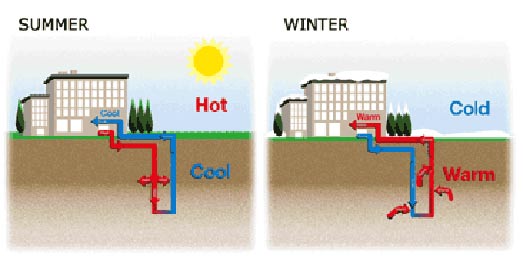|
Geothermal Heat Pumps
Geothermal heat pumps (sometimes referred to as GeoExchange, earth-coupled, ground-source, or water-source heat pumps) have been in use since the late 1940s. Geothermal heat pumps (GHPs) use the constant temperature of the earth as the exchange medium instead of the outside air temperature.
This allows the system to reach fairly high efficiencies (300%-600%) on the coldest of winter nights, compared to 175%-250% for air-source heat pumps on cool days. While many parts of the globe experience seasonal temperature extremes — from scorching heat in the summer to sub-zero cold in the winter — a few metres below the earth's surface the ground remains at a relatively constant temperature. Depending on latitude, ground temperatures range from 7°C (45°F) to 21°C (75°F). Like a cave, this ground temperature is warmer than the air above it during the winter and cooler than the air in the summer. GHPs take advantage of this by exchanging heat with the earth through a ground heat exchanger. As with any heat pump, geothermal and water-source heat pumps are able to heat, cool, and, if so equipped, supply the house with hot water. Some geothermal systems are available with two-speed compressors and variable fans for more comfort and energy savings. Relative to air-source heat pumps, they are quieter, last longer, need little maintenance, and do not depend on the temperature of the outside air. A dual-source heat pump combines an air-source heat pump with a GHP. These appliances combine the best of both systems. Dual-source heat pumps have higher efficiency ratings than air-source units, but are not as efficient as geothermal units. The main advantage of dual-source systems is that they cost much less to install than a single geothermal unit, and work almost as well. Even though the installation price of a geothermal system can be several times that of an air-source system of the same heating and cooling capacity, the additional costs are returned to you in energy savings in 5–10 years. System life is estimated at 25 years for the inside components and 50+ years for the ground loop. There are approximately 50,000 geothermal heat pumps installed each year just in the United States. Read more about:
Return From Geothermal Heat Pumps to Home Page |






